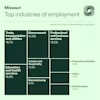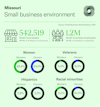 Stephanie Ferguson Melhorn
Stephanie Ferguson Melhorn
Senior Director, Workforce & International Labor Policy, U.S. Chamber of Commerce
Published
September 15, 2023
The state of Missouri has a favorable landscape for businesses and individuals, with a diverse economy, exceedingly strong labor market recovery, and a robust small business ecosystem. Immigrants contribute meaningfully to the state's workforce and economy, while educational attainment, quality of life, and cost of living factors remain promising.
The Worker Shortage Across America
Explore the interactive map below to see the impact of the worker shortage crisis in each state updated September 2023.
The Chamber’s Worker Shortage Index ratio indicates the number of available workers for every job opening. A ratio above 1.0 indicates a surplus of available workers compared to job openings.
Missouri’s Labor Market
Prior to the pandemic, Missouri’s labor market was healthy. While the state's unemployment rate stood on par with the national figure at 3.4%, its labor force participation rate was slightly higher than the national rate of 63.4%. There were 85 available workers for every 100 open jobs.
As of August 2023, Missouri’s labor market was nearly fully recovered, with some metrics measuring even better than they did prior to the pandemic. Missouri’s labor force participation rate is at pre-pandemic levels and the unemployment rate remains lower than it was before the pandemic, and a point below the national average.
On the downside, Missouri is grappling with a large workforce shortage, evident by the fact that there are only 53 available workers for every 100 open job positions in the Show Me State.
Missouri’s Business Environment
Missouri's business environment is diverse, with a robust agriculture and forestry sector, a growing tech industry, and numerous colleges and universities. Additionally, the state is home to nearly a dozen Fortune 500 company headquarters.

Among the industries monitored by the Bureau of Labor Statistics, the trade, transportation, and utilities sector, as well as the education and health services sector, employ the highest number of Missourians, while the construction sector employs the fewest. Missouri’s employment landscape comes from its numerous healthcare firms, in addition to the many automotive and aviation companies which operate in the state.
Missouri boasts a thriving small business ecosystem, with 99.4% of all Missouri businesses falling into this category. Nearly half of Missouri's workforce works within small businesses. Within this dynamic landscape, women own 43% of small businesses, 10.5% are minority-owned, 2.3% are owned by Hispanics, and 8.3% are veteran-owned.

Missouri’s Educational Attainment

Around 92% of Missouri’s population has obtained their high school diploma or its equivalent, two percentage points higher than the national average in 2022. Nearly a third of the population has attained a bachelor's degree, while 12.5% have secured a graduate degree, both slightly below the national averages.

Fortunately for employers in the state, the majority of Missouri college freshmen are remaining in the state for their higher education, where the average in-state tuition is $8,992. Out-of-state tuition in Missouri is $20,877, which is significantly less than the average out-of-state tuition of $28,000. Roughly 360,000 undergraduate students are enrolled in a Missouri college for the 2022-2023 school year. These students supply a rich talent pool from which local employers can recruit talent.
Quality of Life

Missouri's median household income mirrors the national average of around $70,000, which places the state at the 34th rank among all states. Missouri has a progressive tax system, with tax rates varying from 1.5% to 5.3% across nine income brackets. This places the state among those with relatively lower state tax rates.
A quarter of Missouri’s workforce work remote at least one day a week. For those commuting into an office, the average commute time is 23.9 minutes. The Council for Community and Economic Research measures states’ costs of living compared to the national average of 100. Missouri’s cost of living index falls at 88.4, making the state more affordable than the U.S. average, with the fourth lowest cost of living in the United States. The median rent settles at $843, while the median home cost is $239,743, both falling beneath the national average. Nearly 67.6% of the population owned their housing unit in 2021. The state experienced a minimal growth rate of 0.4% from 2020 to 2022.
Immigration

In the U.S., immigrants tend to be of working age in comparison to native-born individuals. As workers, these immigrants are also contributing to support programs like Medicare and Social Security.
Looking at Missouri in particular, immigrants comprise 4.2% of the state's population, totaling 258,741 individuals. Their collective spending power amounts to $7.2 billion, while their tax contributions reach $2.5 billion.
Explore More States
About the authors

Makinizi Hoover
Makinizi Hoover is the Senior Manager of Strategic Advocacy at the U.S. Chamber of Commerce. She leads the housing portfolio and mobilizes resources to address high-priority issues, ensuring effective advocacy on key legislative and regulatory priorities.

Isabella Lucy
Isabella has created stunning visualizations tackling pressing issues like the worker shortage, the benefits of hiring veterans, the lifespan of small businesses, and the future of work.

Stephanie Ferguson Melhorn
Stephanie Ferguson Melhorn is the Senior Director of Workforce & International Labor Policy. Her work on the labor shortage has been cited in the Wall Street Journal, Washington Post, and Associated Press.







